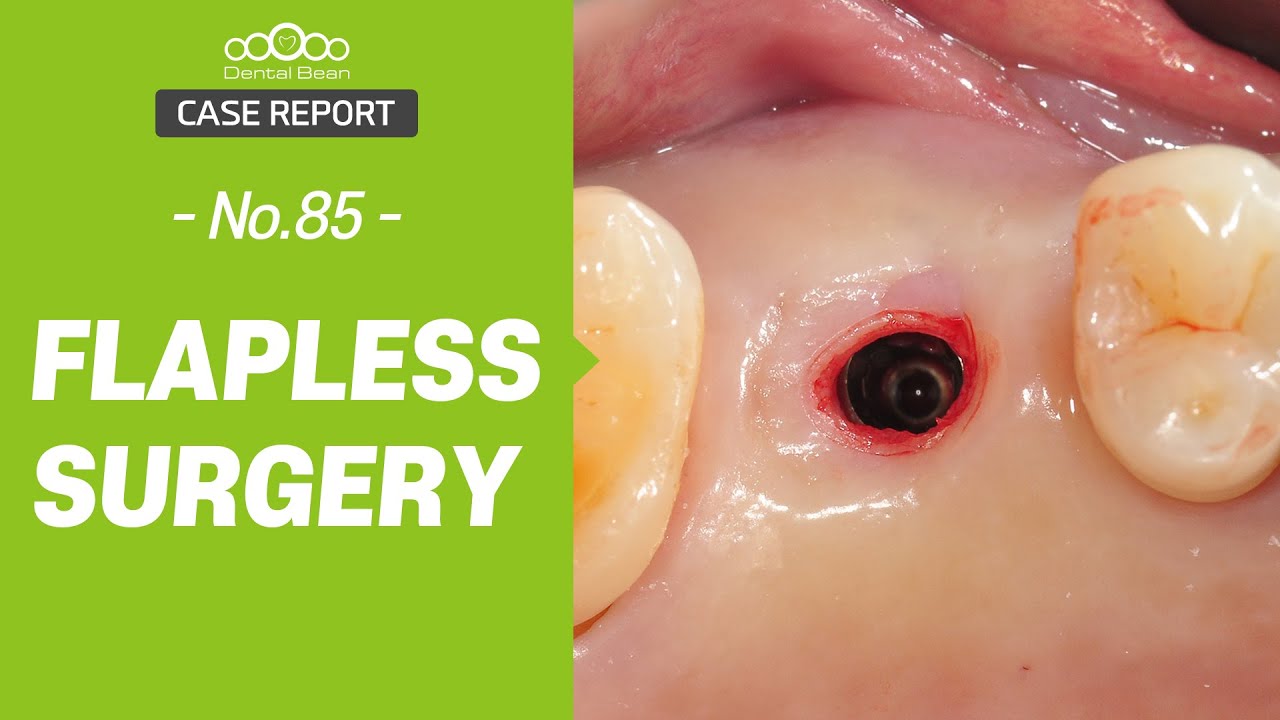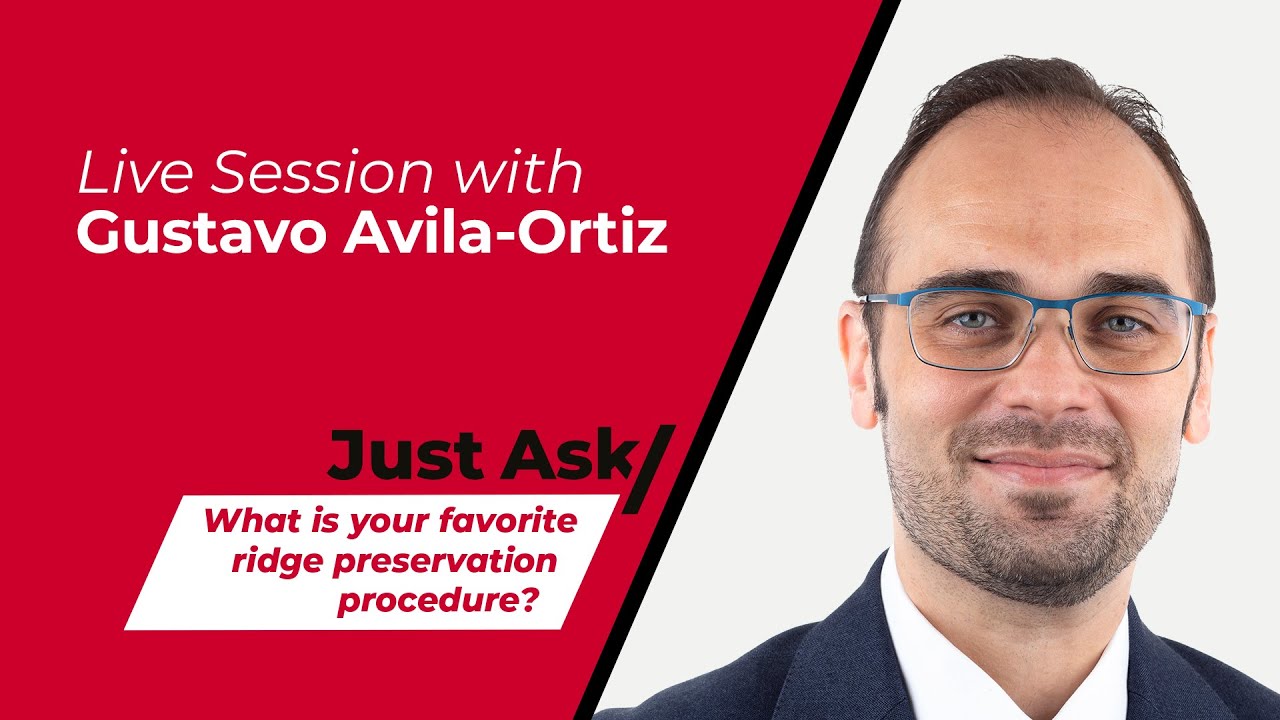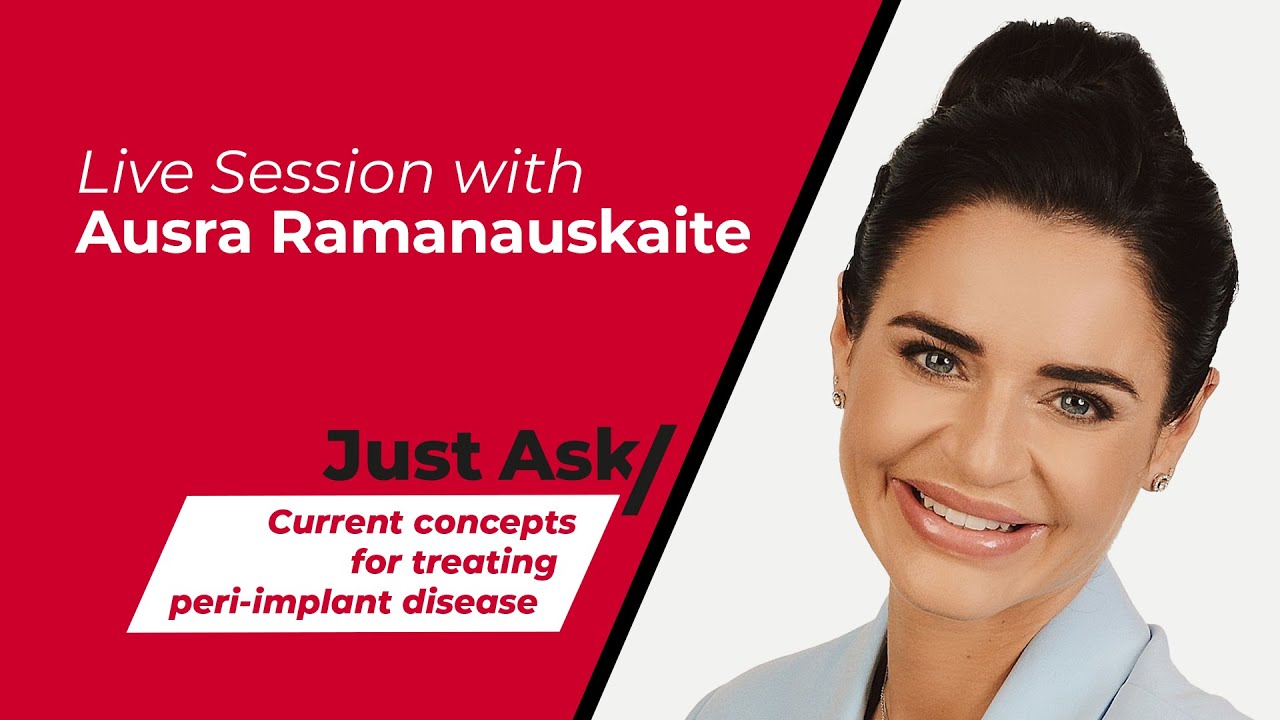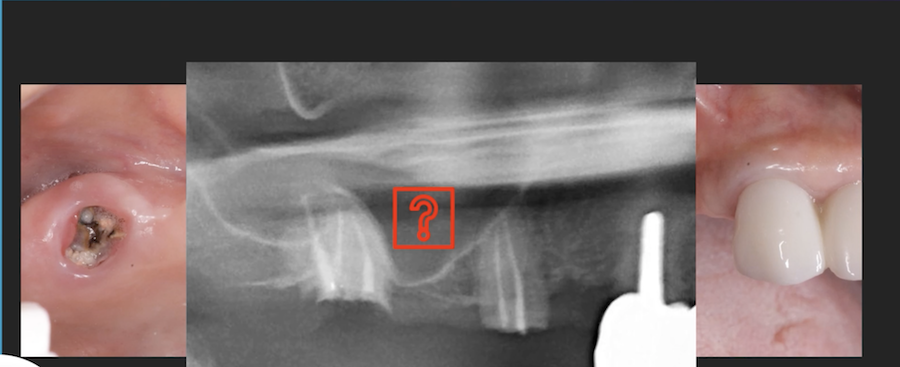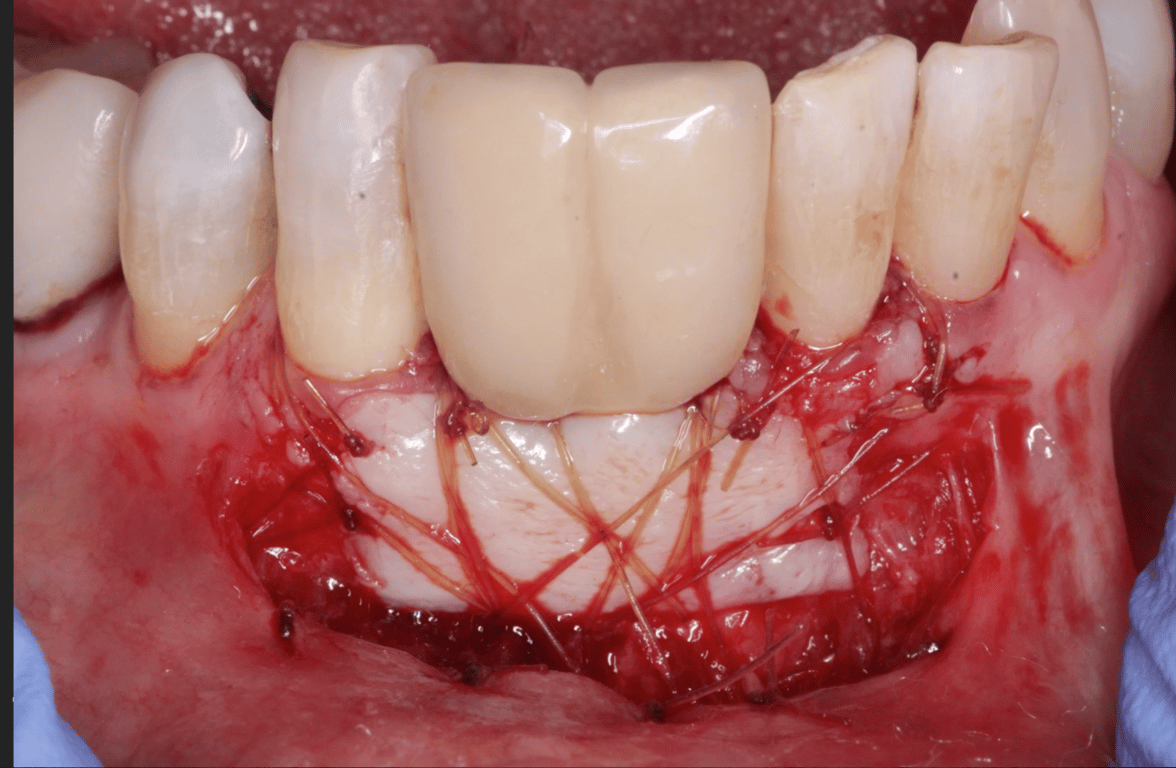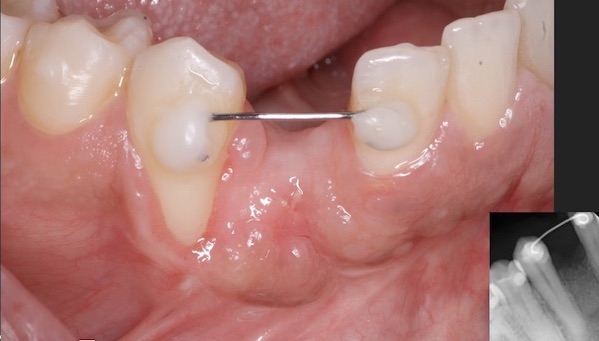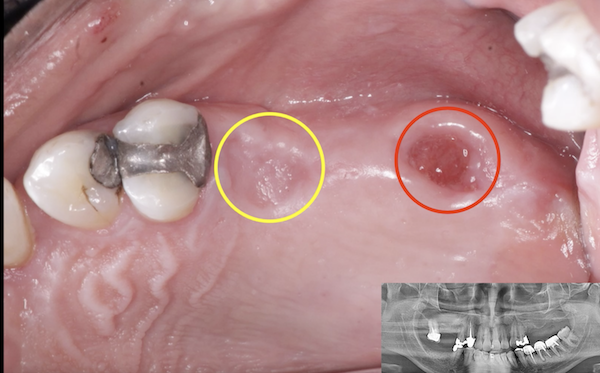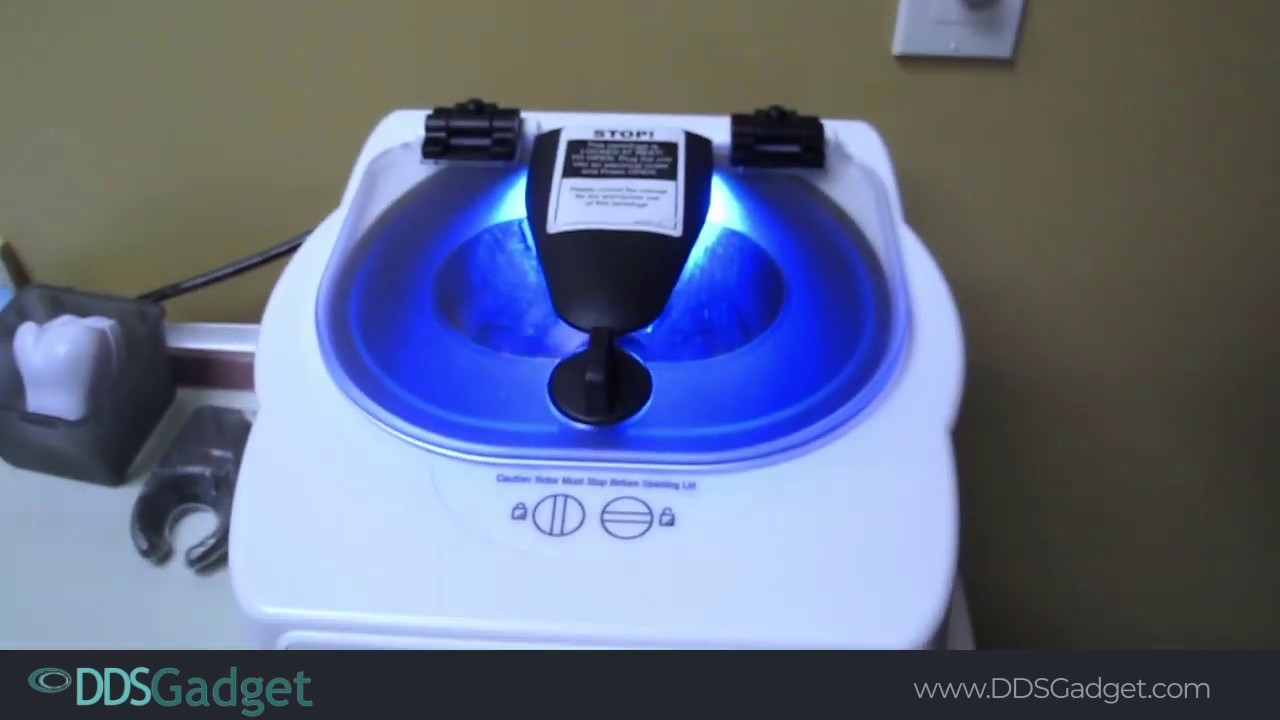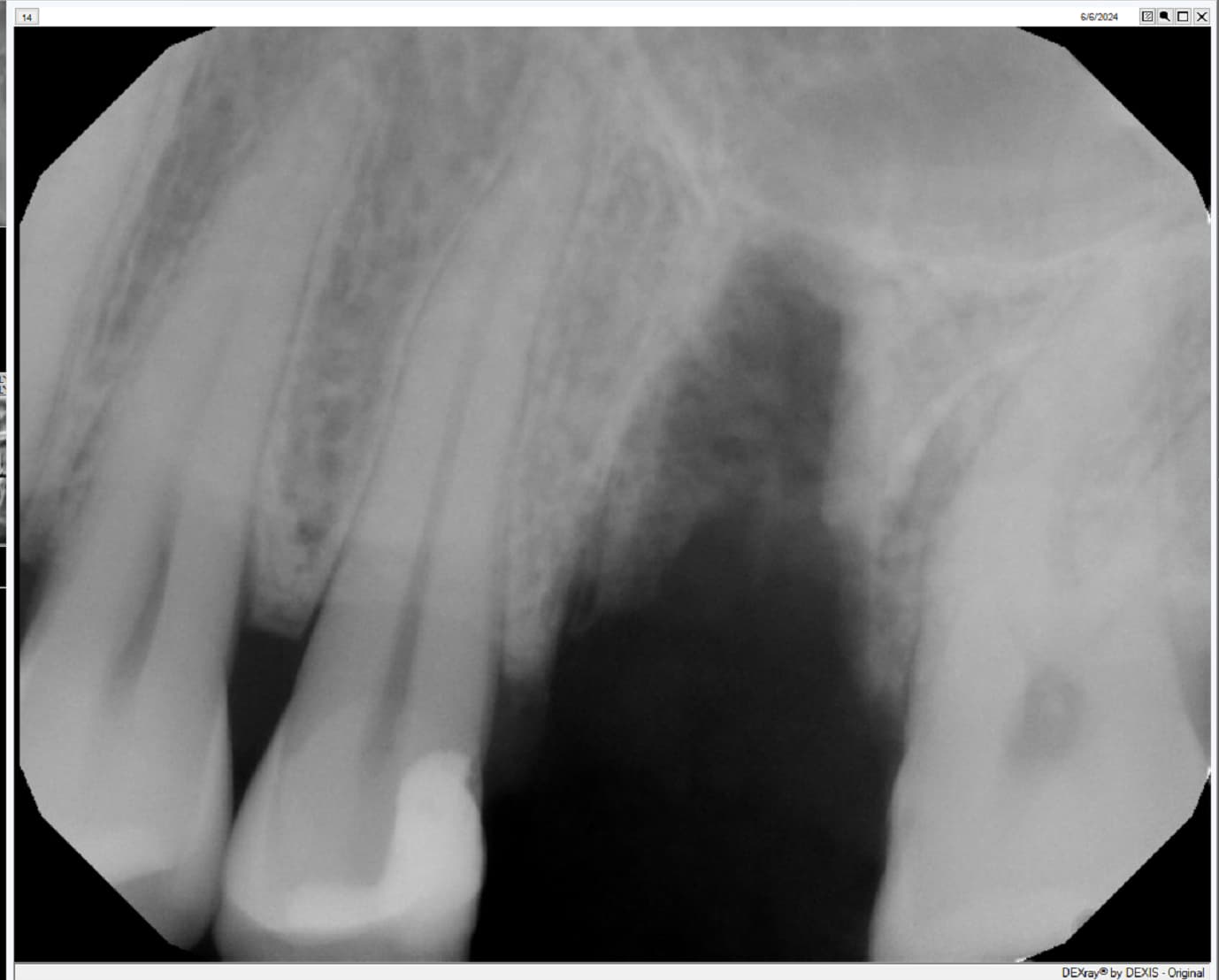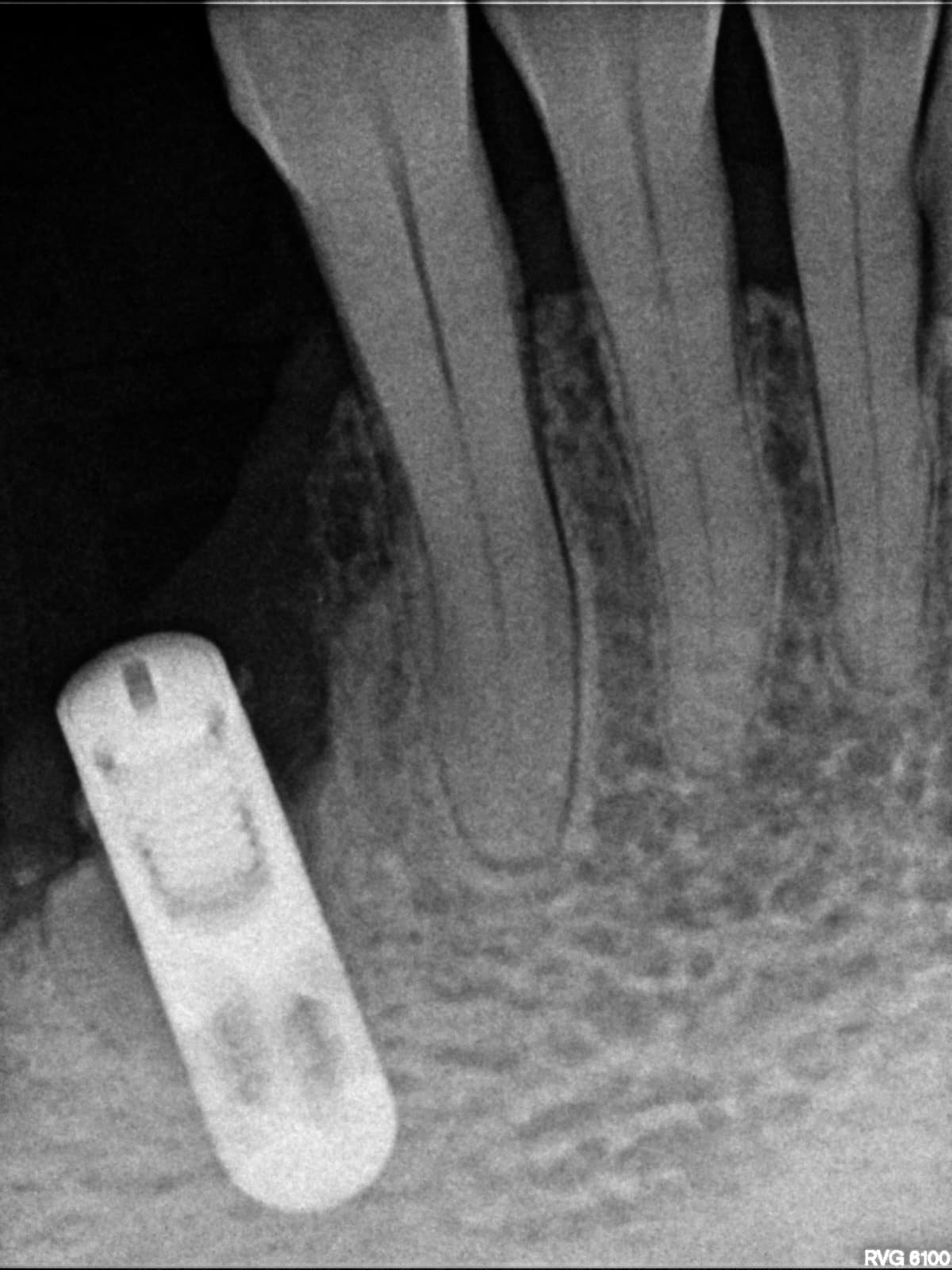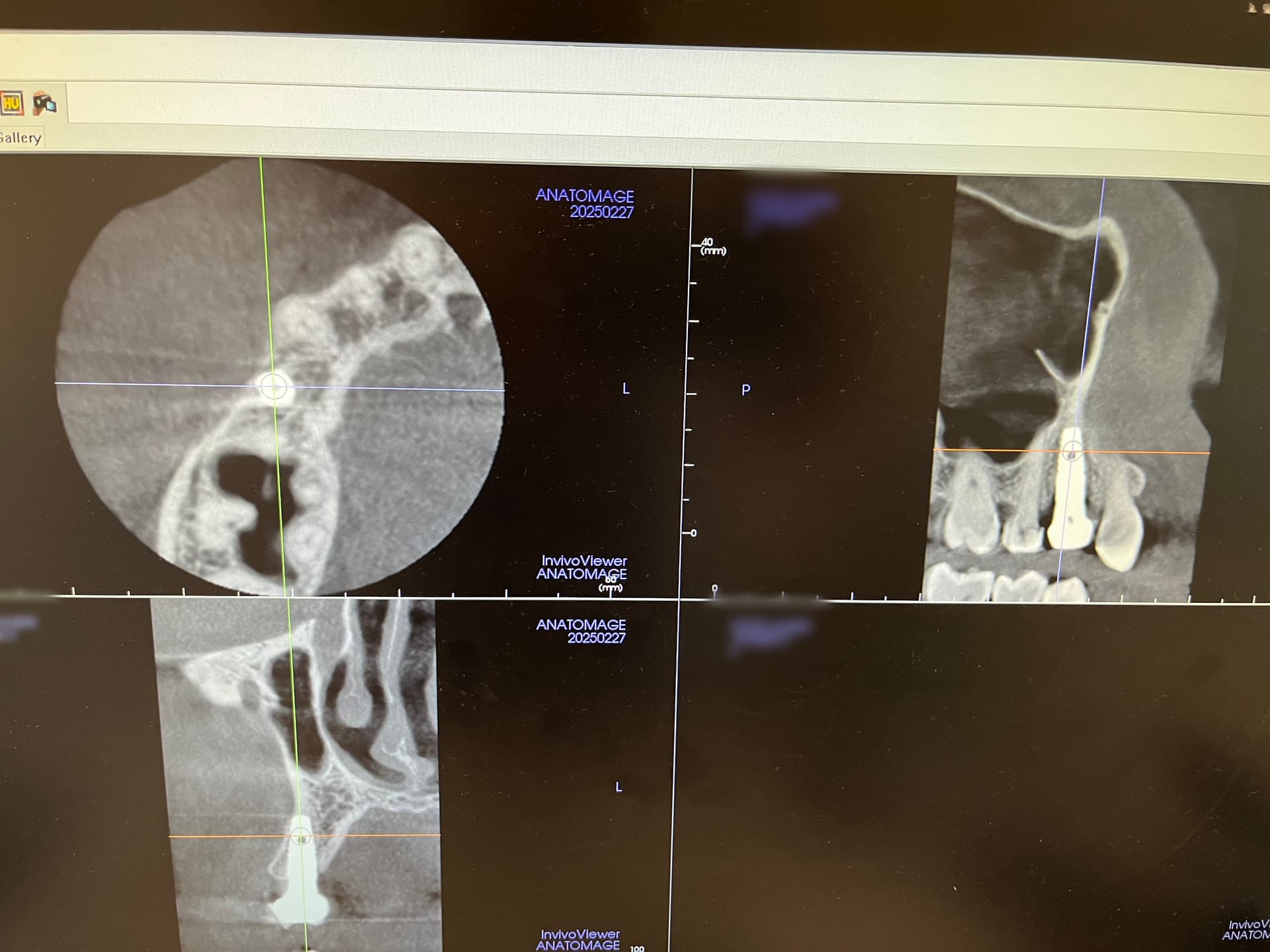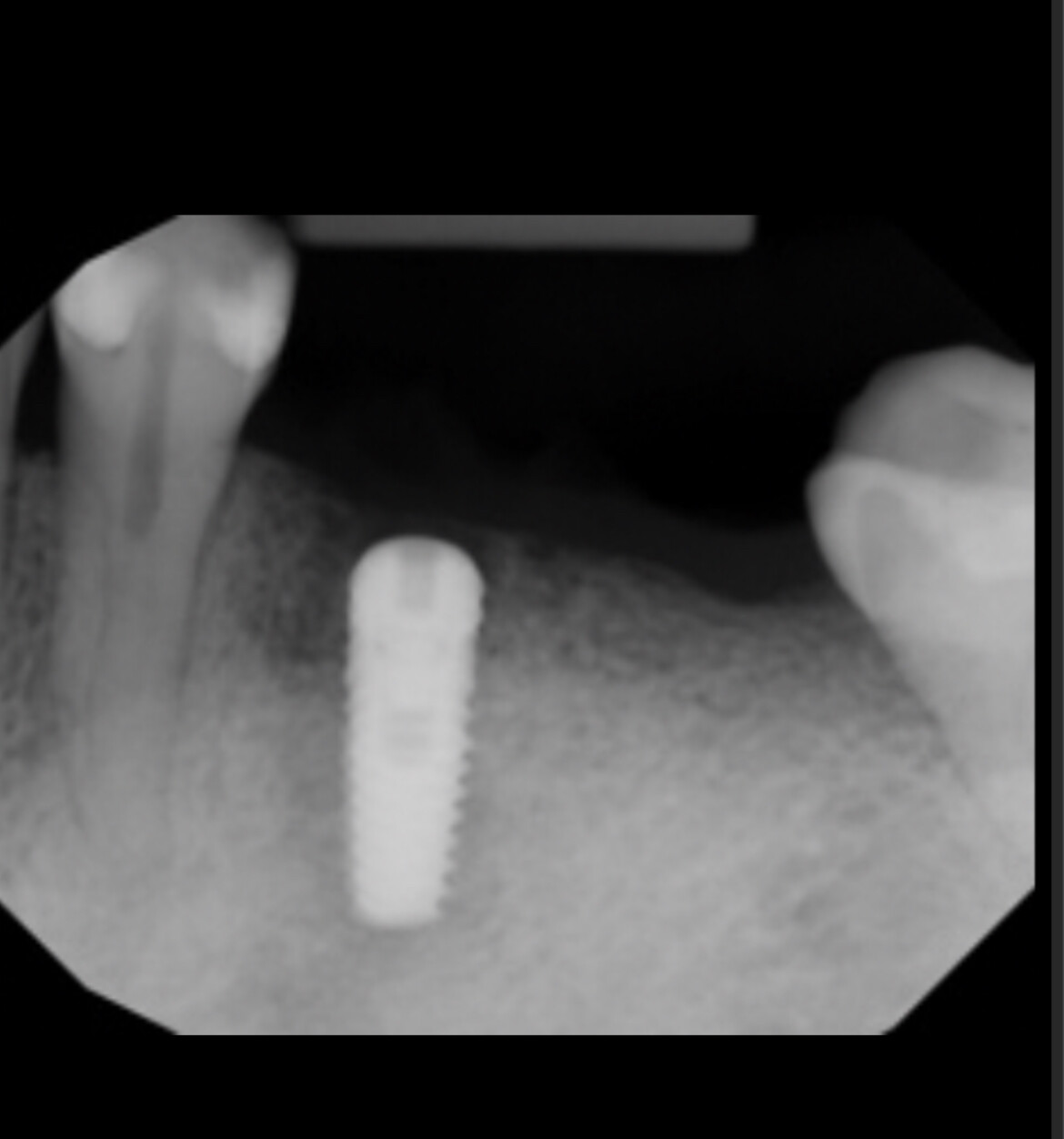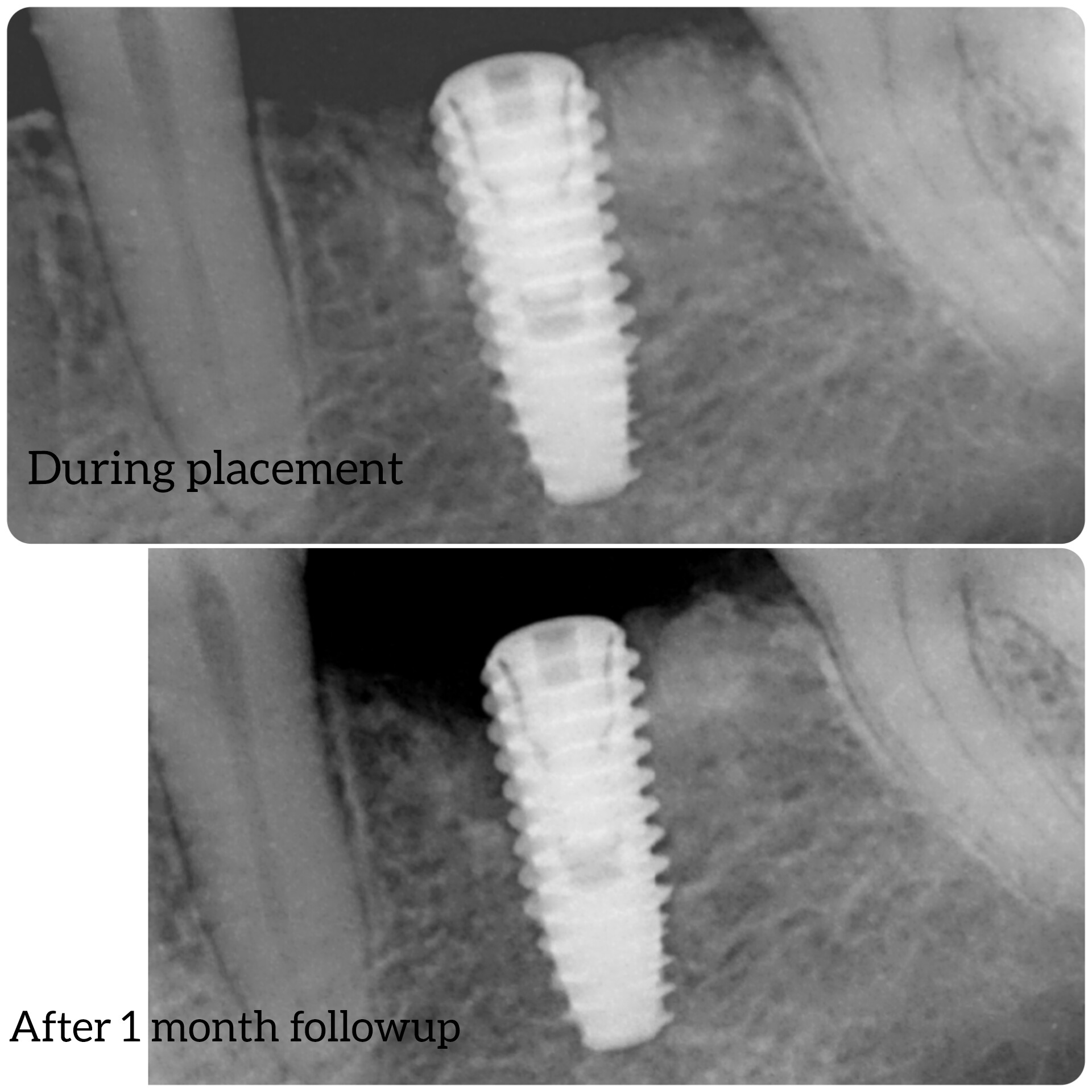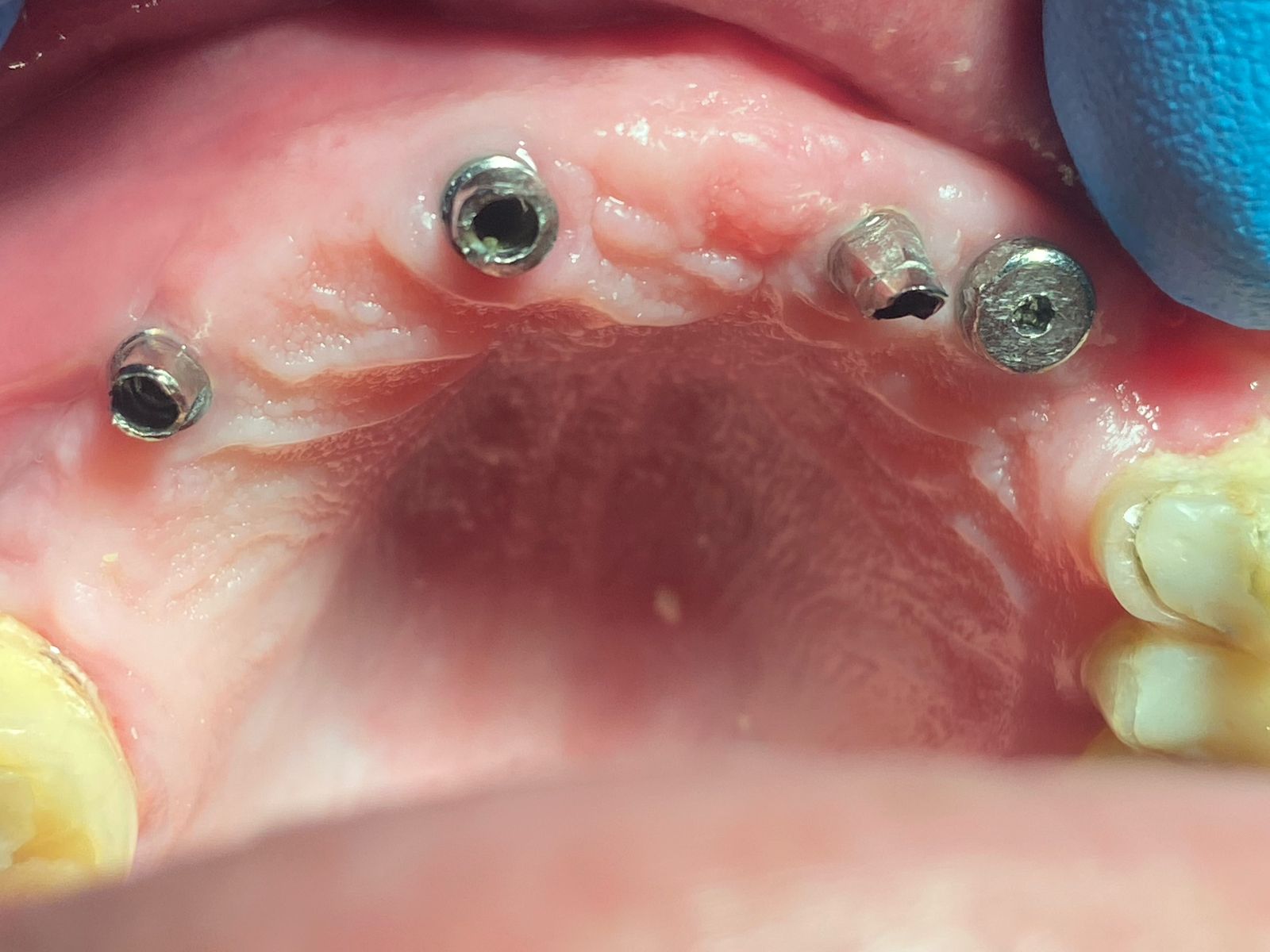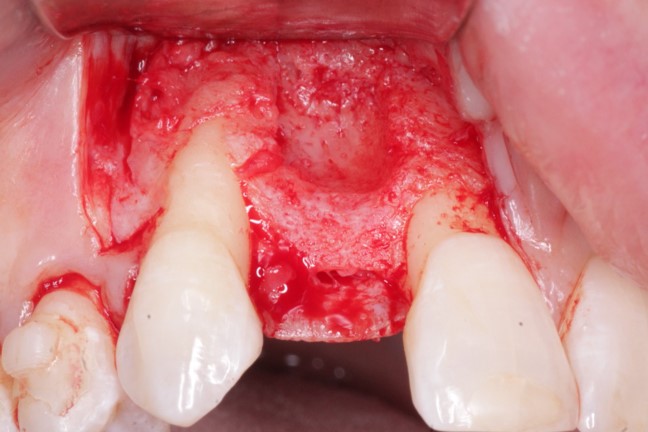Bone Loss Case: Defect 5 Weeks After Placing Single Piece 3mm UNO Implant
Dr. H asks:
Please see xrays below. I am a novice at implants… placed in the single digits. This is a 3mm UNO implant. I know the space was tight, but I went for it. Osteotomy was to 2mm then I compressed to 3mm, since bone seemed soft day of surgery. This xray is 5 weeks post op. For those curious, he has no endo symptoms on adjacent teeth and is otherwise asymptomatic. I believe what has happened here is a lack of vascularity due to the compression during implant placement on the distal. I now have a vertical defect on only the distal, but I am concerned since it is only 5 weeks out. Any advice on how to proceed? Wait and watch? Flap and treat? Thanks.


17 Comments on Bone Loss Case: Defect 5 Weeks After Placing Single Piece 3mm UNO Implant
New comments are currently closed for this post.
Carlos Boudet, DDS
8/16/2010
Dr. H.
You seem to have done a good job in the mesiodistal placement of the implant.
Two concerns worth mentioning are the amount of bone on the buccal of the implant, since 1.5 to 2 mm are desired for stable tissue levels, and the occlusion.
traumatic occlusion or unwanted forces during early healing can result in bone loss at the crestal level.
Since it is a one-piece implant, I would supervise the healing for a longer period of time and watch for any developing mobility. If mobility develops, I would remove the implant, graft and wait, rather than attempt to flap and treat as you mentioned.
Good luck!
Carlos Boudet, DDS
Gregori M. Kurtzman, DDS
8/17/2010
It is possible this is due to loading the implant temp crown during function. In these immediate cases you have to make sure the temp crown is completely out of occlusion in all movements and also there is no contact proximally and instruct the patient to chew on the opposite side. At this point you may consider seating the implant a little deeper under local after curretting the area out without a flap then pack a non resorbable graft material.
Robert Buksch
8/17/2010
I agree with the above comments erxcept I would not try corrective surgery except to remove the implant if it has movement or exudate. This does not look as bad as you may think. Leave it with out load for 4 - 5 months more, provided that no signs or symptoms that are indicative of a worsening condition develope. The implant appears a little short for a heavey load so be careful to keep the occlusion light on the final restoration. Take a look at Intra-Lock MILO implants you may like what you find.
Daniel Sweet
8/17/2010
I see a couple of problems. First,safe distance for an implant and a natural tooth is: 2mm + radius of implant. In this case we are crammed. Secondly, I would have used your 2mm twist like you did, then follow it up with a 2.5 mm or so and call it a day. The bone compression enlargement exacerbated the already tight distal area. The Uno has aggressive threads already. Always final rinse with sterile water and suction out before placement to eliminate hydraulic compression. Read up on bone grafting the area. Good luck !!! Dano
Richard Hughes, SS. FAAID
8/18/2010
When you place an immediate load implant, one needs absolute stability, without true centric and lateral excursive loading (contacts). Also the adjacent teeth have to be nonmobile. Thus, it's for show and not for go!
AJW
8/18/2010
Hai, i have same situation here.
I place one anthogyr implant (Diameter)4mm x (leght)6,5mm (2piece body and abudment) in 47 with imediate loading.
this implant insertion with 15-20 Newton torque. and have initial stability.
but, after 3 weeks its have mobility. and increase in 2-3 days.
I advice to patient to use dental guard plastic in anterior teeth so the implant not contact with antagonis tooth. after 4-5 days, the mobility is decrease. but i still follow up in 4 weeks.
i hope its got more stability again.....
if in 8 weeks is still have mobility i choose to extract this implant, and insertion again with new implant (diameter)4,5mm x (lenght)8mm
can its success????
hw brueggen
8/18/2010
It is too easy to start over to wait and see. If this was one piece to a larger case perhaps. But with this, remove the implant, enucleate all fibrous tissue, graft with mineralized freeze dried bone, cover with a collagen membrane such as Biomend Extend, provisionalize with a flipper or bonded pontic, wait 4 months, and repeat procedure with the lessons you've learned and a two piece implant. As your experience is limited consider a two stage procedure with at least 4 months before loading, 6 prefered
Dr. H
8/19/2010
Hi all. I am not sure if everyone followed exactly: there has never been mobility on this implant, but anyways, i'll update.
I am now 4.5 months out. the implant has no mobility, there is no additional bone loss. It now has a provisional on it and I am planning to wait to 6 months to restore it.
I guess sometimes it's best to wait and see. I sometimes say "let sleepings dogs lie"...
K. F. Chow BDS., FDSRCS
8/20/2010
Dear Dr H,
After 4.5 months and if there is no mobility, and if it gives a sharp ringing sound when tapped with the handle of your trusty probe....it is osseointegrated. You can place in the permanent crown safely.
You do not have to trouble your head too much over the bone loss as you are using a single piece implant which does not have an abutment-fixture margin that can exacerbate bone loss. I have seen many of my cases where after several years, showed bone growing back.
According to Wolff's law, "The principle that every change in the form and the function of a bone or in the function of the bone alone, leads to changes in its internal architecture and in its external form."
That is how the direct stimulation of bone by osseointegrated dental implants not only maintains the integrity of the bone but coerces it to grow back.
Afshin Danesh
8/20/2010
DEAR DR.H
Check the ff.
the premature contact , heavy occlusal force, contact point ,the amount of bone loss distally and if in buccal.
correct any disorder if needed and wait, then if in early loading in the future with the final crown ,the bone loss continues to the threads, its much better to explant it, and to augment the bone , place a new one 4 months after.
Dr. Ajay Vikram Singh
8/21/2010
If we look at the x ray there is more bone resorption/ defect on labio-distal area. my openion is remove all the occlusal forces on the provisionalans ask the patient to avoid any undue forces on the implant. wait for 4 months and 1. if there is any sign of pain/ pus discharge/ implant mobility then remove the implant and go for GBR after 6 weeks and implant placement again after 4 month. 2. if you have no clinical signs of any complecation except just the same defect visible in the x ray then give an vertical incision on the first premolar area atleast 4-5 mm above the free gingiva of the premolar then elevate the periosteom with pouch technique to reach the defect with breaking the tight soft tissue seal at the cervical part of the implant. currette out all the granulation tissue from the defect and fill the defect throught the pouch with the dense hydroxyappetite plus calcium triphosphate grfat material ( mediaum particle size- 1.0-1.5 mm)and let it heal to generate new bone for 4 months then load the implant. if need any discussion for this pouch technique you can write me on [email protected] i will feel happy to help you in any way. good luck.
Dr. Dominik N.
8/22/2010
Dear Dr. H.
What was the reason?
1. Failure planning: not enought space for implant procedure, mesio-distal diameter of the premolar in this case 6,92mm. The canine 7,38mm. The space where you put the implant 5,07mm. If you have no any complication the esthetic outcome would be unesthetic! And I did'n mention the permanent gum inflamation around the suprastucture!
Fortunatelly you have problem with the osseointegration because your implant killed the vessels of the bone. My be.
Or you put a temporary crown onto the implant, and your patient have a malocclusion and every night do bruxism and killed his bone around the implant. Because you do a Benett movement, your canine and first premolar will drive the moving and get the highest occlusal force. Imagine this force every night under sleeping, under bruxism. Did you checked the position of the canine/ectopical to vestibular position/, and the abrased surface of it before implantation? Checked the panoramic x-ray of your patient. If he has erupted wisdom teeth you are sure he has bruxism!
2. The surface of the implant was contaminated!
Solution: take out the implant. Do an orthodontic treatment and make enough space for an esthetic premolar, or close the space.
Exam the surface of the removed implant on a closed medical university with scanning electronic microscope, and if you find any piece of aluminium-oxide particule on the surface, write me!!!
greg steiner
8/24/2010
In my opinion everything you did was correct. Compressing the bone does not cause this type of defect. The bone was "compressed" 0.5 mm and maybe not at all because this is about the length of the threads. I regularly do more compression when I am placing implants in sinuses with minimal bone. It is not due to proximity of the adjacent teeth. I have placed many implants in areas separated by only the thickness of the cribriform plate (lamina dura) with no bone loss over years. The 2mm rule is a good rule if you are not very experienced but if you have placed thousands of implants you know how to violate the rule and make it work. This patient has what appears to be active periodontal disease. The tooth distal to the implant has a significant angular defect. The implant was placed in active infection which resulted in the distal angular defect. If the implant is restored it will fail at some time. I suggest you treat the patient’s periodontal disease and remove the implant at the same time. I do not suggest mineralized allografts because they are nonresorbable and will shut down vitality in the area due to the presence of antigenic proteins in the allograph. I would graft with Socket Graft but of course I am biased. Greg Steiner
Tony Widmonte
8/25/2010
I agree with Dr Steiner. If you are new to the "game"
its probably safer to follow his advice as long as you have patient co-operation to redoing the whole procedure but if you explain the pros and cons they usually agree - he seems to be the only one who has noticed that there could be some perio envolvement on the mesial of the 5 which could account for the problems on the distal area of the implant.
By the way Dr Steiner the material you metioned - the Socket Graft that you are biased about where can I get more information about it.
yossi k
8/25/2010
DR H. You did a beautiful job of precision placement. Could you post a preop picture (xray). when they work it's great when they give you problem everyone clutches at straws to critique it. keep them out of occlusion especially lateral excursions.try to keep 1.5 -2 mm of bone buccal to implant. live with bone loss to the top thread .Go to lot's of courses . Try to spend time watching your oral surgeon place them then watch the periodontist then watch a Gp with experience . Have fun do your best and inform before you perform. Thank G-d we are not brain surgeons. Feel free to contact me with any questions.
dr GM
10/11/2010
i love the discussion i'm a Gp that recently start putting implant,and i'm getting addicted to placement and restoring implant.Great coments
roberto sosa dds
6/1/2011
this phenomenom is called sauceration as described by dr. norman Cranin (recently passed away)he described it as the circular bone resorption that occurs about the necks of endosteal implants shortly after insertion

